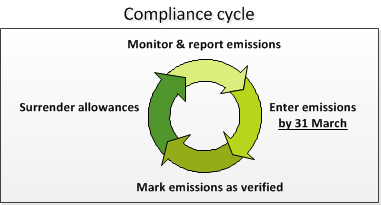Compliance cycle
Industrial installations and aircraft operators covered by the EU-ETS are required to have an approved monitoring plan, according to which they monitor and report their emissions during the year X. In the case of industrial installations, the monitoring plan forms part of the approved permit (also required). These permits are handed out by the Belgian competent authorities (the regions).
The operators (of industrial installations and the aircraft operators) must designate an independant verifier from the list of verifiers accredited by the competent authorities. Before the end of February each year, the operators must report their emissions of the previous year and must have this verified by their verifier. The verified emissions are then passed to the competent authorities, which verify them in turn. Afterwards, the competent authorities send the list to the Belgian registry administrator, who will upload them into the registry. Normally, the result is validated once more by the competent authorities and afterwards the figures are validated in the registry by the registry administrator by March 31 of year X+1. Only after this last validation, the emission figures are binding for surrendering.
On September 30 of year X+1 at the latest, the operators must surrender an amount of allowances in order to compensate for the emissions of year X. If this surrendering obligation is not fulfilled in time, operators face a huge fine of € 100 per allowance that was not surrendered. Moreover, this fine does not lift the obligation to surrender the missing allowances.
This annual procedure of monitoring, reporting and verification (MRV), as well as all processes connected to these activities, is known as the 'compliance cycle' of the EU-ETS.

[Back to the top of this page]